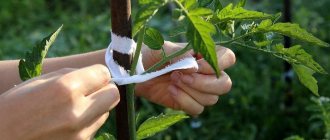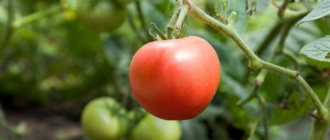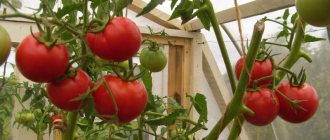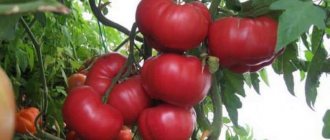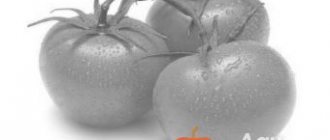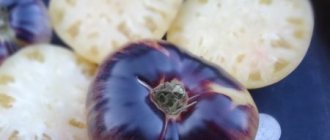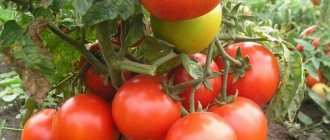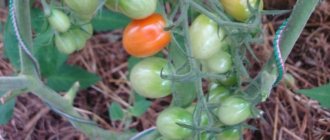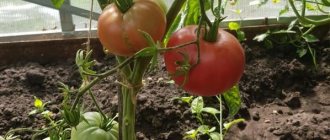Tomato Geranium Kiss is a very beautiful cocktail tomato with small red fruits collected in huge clusters. It decorates the garden bed, and the harvested crop is great for decorating dishes. Its taste is not inferior to its appearance and is very pleasant.
| Height | Landing location | Ripening time | Fruit color | Fruit size | Origin | Fruit shape |
| short | Greenhouse, Open ground | Early ripening | Reds | Small | Variety | With spout |
Description of the tomato variety
A low-growing determinate-type tomato variety grows no higher than 50 cm in open ground, and up to 70 cm in closed structures. The plant produces a small number of side shoots, which are not removed; they are used to form a bush. The tomato belongs to the early ripening varieties: from the moment the seeds are planted to the harvest, the tomato takes approximately 90 days.
The variety belongs to the cherry variety, grown in areas with warm weather conditions, in temperate regions, Geranium Kiss tomatoes are rare. The variety is not frost-resistant; cultivation is possible only in protected areas. External description of the tomato “Geranium Kiss”:
- The compact bush does not grow to the sides; the central shoot is thick with a rigid fibrous structure and holds the weight of the fruit without additional fixation.
- The foliage of the variety is dense, formed along the length of all shoots, the leaves are rich green in color, oblong in shape, slightly pubescent and corrugated. Edges with slight blunt teeth.
- The “Geranium Kiss” tomato blooms with bright lemon flowers, during flowering the bush looks like a yellow ball, the tomatoes are self-pollinating, 100% produce ovaries.
- A special feature of the tomato variety is its complex long clusters; the plant forms up to 6 clusters, the density of which is 90 pieces of small-fruited tomatoes. The indicator is average; there are clusters with 110 fruits.
- The powerful deep root system fully provides the tomato with nutrition. The root circle is wide.
Attention!
The harvest is harvested together with the cluster at the stage of technical ripeness - in this way the shelf life of the fruit is increased. The “Geranium Kiss” tomato, due to its decorative appearance and compactness, is grown on balconies and loggias in large flower pots.
Description of fruits
Small-fruited tomato varieties are usually classified as cocktail varieties. Characteristics of the “Geranium Kiss” tomato:
- oblong in shape, at the end of the fruit there is a clearly defined appendage in the form of a drop;
- tomato weight from 15 to 35 g, no larger than an average walnut;
- the peel is thin, bright crimson, the surface is glossy without ribbing;
- the color is uniform, the tomatoes do not crack, they retain their presentation for 6 days after harvest;
- the seeds are small, located in 6 chambers, have good germination for more than 3 years, and do not lose varietal characteristics;
- The pulp is dark red, juicy, the structure is dense without voids.
The tomato variety “Geranium Kiss” has a high gastronomic rating.
Reviews
Bushes of the Geranium Kiss variety attract attention with their abundant flowering, neatness and branches strewn with miniature scarlet tomatoes. Everyone who tried to grow the crop was satisfied with the result.
Vera, Liski : “A friend shared with me the tomato seeds. I planted the bushes in the greenhouse in mid-May. The variety is excellent, bears fruit consistently. The fruits are tasty, sweet, aromatic, and can be stored in the refrigerator for a long time. We ate it fresh.”
Irina, Krasnodar : “Two years ago I got hold of the seeds of the Geranium Kiss. I grow it by sowing directly into the ground. In our climate this is permissible. I water according to the rules, I try not to spread dirt in the area, tomatoes don’t like that. I feed with ready-made organic and mineral fertilizers. When it’s hot, I cover it with agrofibre, otherwise the skin burns and turns yellow, but the taste doesn’t change.”
Characteristic
The early-ripening determinate tomato variety “Geranium Kiss” is characterized by high yields for its growth. Easy to care for. Resistant to a number of fungal infections. Propagated by seeds from the parent plant.
Productivity and fruiting
In the Russian Federation, “Geranium Kiss” tomatoes have been grown since 2010. During this period, the culture has found wide distribution among farmers and amateur vegetable growers. The “Geranium Kiss” tomato owes its recognition to its early ripening and high yield. The amount of fruiting can be affected by early planting of the crop in poorly warmed soil. Excess moisture is undesirable for the variety: tomatoes will not grow in a wetland. Prefers neutral, fertile soils.
If you follow agricultural technology: a sufficient amount of ultraviolet light, periodic fertilizing, and not excessive watering, they will provide a yield of up to 2 kg per unit. The “Geranium Kiss” variety is compact: for 1 sq. m plant 4-5 tomatoes, fruiting on average up to 10 kg. These indicators are the same for greenhouses and open ground. The first ripe bunches are cut in July. The tomato variety ripens unevenly; the growing season lasts until October. In a protected area - two weeks longer.
Area of application of fruits
Tomato variety “Geranium Kiss” for universal use. Cultivated by agricultural complexes for commercial purposes. Picked fruits at the stage of technical ripeness are stored for a long time without loss of taste and appearance, and are safely transported. Tomatoes grown "Geranium's Kiss" on a personal farmstead are used for cocktails, juice, and consumed fresh. The small size of tomatoes is suitable for canning whole, preparing vegetable snacks, and pickling.
Resistance to diseases and pests
Tomatoes of this variety are characterized by stable immunity against viral and bacterial diseases. If the humidity of the air or soil is increased, damage by fungal spores is observed. Late blight occurs rarely; infection with cladosporiosis and tobacco mosaic is possible. Parasitic pests:
- spider mite;
- whitefly moth larvae;
- Colorado potato beetle;
- less often - slugs.
Advantages and disadvantages of the variety
The advantage of the “Geranium Kiss” tomato is:
- Unpretentiousness of agricultural technology.
- Tomatoes do not require additional installation of a trellis or poles.
- There is no need to tie or remove stepsons. After the bush has formed with 4 shoots, the culture does not produce shoots.
- The leaves are not cut off; the harvest takes place along with the bunches; there are no empty clusters left that are removed.
- The bush has a decorative appearance, both during abundant flowering and fruiting, and is grown in open ground, on the balconies of city apartments, open verandas, and in greenhouses.
- Fruits with good taste and juicy pulp of universal use.
- The crown of the plant does not grow to the sides; the bush is compact and does not require a large area for growth.
Disadvantages include intolerance to high humidity and poor resistance to parasites.
Transplantation technique
The optimal time for transplanting plants into an open bed is the end of May, into a greenhouse - the first ten days of May.
10 days before transplanting, the seedlings are accustomed to fresh air - they are taken outside every day and kept in a well-lit place by the sun for 2-3 hours.
A day before the transplant, she is left to spend the night on the street.
Preparing the site
Tomatoes love to grow in a sunny place, where there is no stagnant water or strong winds. They prefer loamy or sandy loam soil, flavored with organic matter and mineral fertilizers.
The soil is prepared in the fall - it is sprinkled with humus or compost (10 kg), wood ash (3 kg), superphosphate and potassium salt (100 g each) per 1 m². After this, digging and leveling with a rake are carried out.
Tatyana Orlova (Vasilidchenko) (candidate of agricultural sciences):
Autumn digging is carried out without loosening, in blocks. If you loosen the soil in the fall, it will become compacted over the winter and will have to be dug up again in the spring.
In early spring, the soil must be disinfected - it is sprayed with a urea solution (150 g per 10 liters of water).
Planting scheme
This plant has a compact shape and short stature, so the optimal planting pattern is 40x50 cm. The maximum number of bushes per 1 m² bed is 6-7 pieces.
Dig out the holes, pour water with the addition of a complex solution of nitrophoska (1 tbsp per bucket of water). Consumption per hole - 0.5 l.
When the moisture is absorbed, the bushes are planted, the roots are sprinkled with soil without fertilizers and hilled up to provide them with stability and to avoid rapid drying out of the soil.
Growing rules
The tomato variety “Geranium Kiss” is propagated by seeds from the parent plant. Two ways: seedlings and sowing seeds directly into the soil in the garden bed. The second method is suitable for the Southern District. Prerequisites: sufficiently warm soil and suitable soil composition. Work begins in early May. This method is rarely used due to the threat of night frosts. It is more effective to grow tomatoes as seedlings.
Planting seedlings
Tomato planting material is disinfected with a manganese solution, soaked for 4 hours, then placed in a growth-promoting preparation for 2 hours. The planting mixture is prepared from river sand, neutral turf soil, and peat in equal proportions. Pour into boxes, containers or peat glasses. If you use a small container, diving will not be necessary. Sowing seeds:
- Planting material is laid out in furrows 2 cm deep, one by 1.5 cm.
- Moisten the soil and pour a layer of soil on top of the peat.
- Cover the container with glass or film to create a greenhouse effect.
- Place in a room with good lighting and constant temperature (+25 °C).
After the tomato has sprouted, the covering structure is removed. Water the plant when the top layer of soil is completely dry. Feed with mineral fertilizers. After the second leaf appears, they dive. Work is carried out in early April.
Landing
The seedlings grow quickly: at the beginning of May, the tomato variety “Geranium Kiss” blooms - this is an indicator that the tomatoes need to be planted in a closed place. In an unprotected bed as the soil warms up, approximately mid-May. The planting scheme in the greenhouse and open ground is the same: per 1 sq. m – 4–5 plants. The distance between bushes is 30 cm, in rows – 0.5 cm.
Aftercare
Tomato “Geranium Kiss” is recommended to fertilize three times a day:
- during planting - organic matter;
- flowering - phosphorus fertilizer;
- fruit formation - potassium-containing agent.
Also required:
- Moderate watering no more than once a week.
- Weeding.
- Prevention of infection and insects parasitizing the crop.
The variety does not require garter. There is no need for pruning and constant formation of the bush.
Outdoor care
Let's consider the conditions under which this tomato variety will develop well and produce a harvest.
Watering
Watering is carried out in the morning or evening by drip irrigation. The frequency of watering depends on the condition of the soil. For “Geranium Kiss”, both waterlogging and insufficient moisture are equally harmful. When watering, do not allow water to get on the leaves.
Feeding
The roots of these tomatoes spread underground over the entire area of the garden, so fertilizers need to be applied to the entire surface, and not just under the bush. Fertilizing is done once every 10 days along with watering. It is best to use mineral complexes that already contain the necessary nutrients.
Find out how to properly feed tomatoes using yeast, iodine and boric acid.
The following drugs have proven themselves well:
- "Plantafol";
- Nanovit;
- "Biopon".
Stepsoning
Due to the short stature of the bush, pinching is not required. It is recommended to form 4 stems for greater yield. Experienced gardeners advise removing the lower leaves when forming a cluster; this will improve ventilation and prevent the appearance of pests and diseases.
When grown in a greenhouse, the bush can grow up to a meter; in this case, the shoots are pinched and the bush is formed into 2 stems.
Soil care
The beds are regularly weeded to get rid of weeds. Once every 2 weeks, a loosening procedure is carried out to provide the roots with free access to moisture and air. For loosening and weeding, it is convenient to use a tool such as a Fokina flat cutter. To save time on weeding and loosening, the soil in the beds is mulched, creating a layer 5–7 cm thick (from hay, straw, sawdust, compost), which will protect the soil from overheating and retain moisture. Proper mulching eliminates the need for too frequent weeding.
Tying up a bush
Bush staking is used to prevent semi-determinate and indeterminate plants from creeping along the ground. Despite the fact that the bush of the tomato in question is compact and low-growing, it still needs tying up so that it does not break under the weight of the brushes.
To do this, first tie up the main trunk, and then, as it grows, the side stems.
For gartering, one of two methods is used:
- Support . The bushes are tied with ribbons to vertical wooden supports (pegs) about a meter high (for greenhouse tomatoes - 1.5 m).
- Trellis . At opposite ends of the beds, stable posts are placed, between which a horizontal trellis is attached, to which the bushes are tied, first by the top, and in the process of ripening, by the brush.
Pest and disease control
To exclude a number of diseases, it is recommended to adhere to crop rotation: do not plant tomatoes in the same bed for more than four years. The proximity of nightshade crops is excluded. For preventive purposes, the tomato variety “Geranium Kiss” is sprayed with copper sulfate. Last year's roots and stems of weeds are removed. Before planting, dig up the soil.
“Commander”, “Iskra Bio”, “Confidor” are used against pests depending on the type of parasite. The tomatoes and the root circle of the soil are treated against the fungus with Bordeaux mixture and the product “Hom”, “Barrier”.
How to choose seedlings?
If you were unable to grow seedlings yourself, you can buy them. But in order not to be disappointed with the result, it is important to choose the right planting material.
Rules for choosing seedlings:
- Take seedlings that are strong, with intact roots.
- The first flowers should appear on the seedlings. If there are no flowers on the seedlings yet, this indicates that they are not ready for planting. If seedlings are planted too early, they will lag behind in development or stop growing altogether.
The “Geranium Kiss” variety loves fertile and loose soils no less than other tomatoes. Recommendations:
- The soil should be neutral or slightly acidic, pH level no more than 7.
- If the soils are poor and infertile, they must be fertilized with humus and peat. It is also useful to add river sand.
- It is better to grow tomatoes in areas where pumpkins, zucchini, and cabbage grew. The worst predecessors are all nightshade crops. If potatoes, tomatoes, peppers or eggplants grew on the site, it is not suitable for “Geranium Kiss”.
- If the soils are fertile, you should not apply a lot of fertilizers - they are not needed at the beginning of the growing season.
The soil for growing seedlings must be disinfected: frozen or treated with potassium permanganate. Steaming for 45 minutes is also recommended.
Productivity
Geranium Kiss tomatoes have a universal purpose. The harvest is harvested together with the clusters at the stage of technical ripeness. This allows you to store products longer without loss of taste and presentation. Unripe tomatoes are stored in wooden boxes in two layers. Several ripe fruits are placed between them to stimulate ripening. The process takes approximately a week.
Ripe tomatoes are stored for a long time in the refrigerator or cellar at a temperature not exceeding 10 °C. The fruits are used for making salads, tomato juice, snacks, drying, pickling and pickling.

